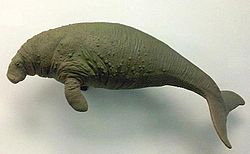Steller's sea cow
Steller's sea cow (Hydrodamalis gigas) is an extinct aquatic mammal.
| Steller's sea cow | |
|---|---|
| Conservation status | |
| Scientific classification | |
| Kingdom: | |
| Phylum: | |
| Class: | |
| Order: | |
| Family: | |
| Subfamily: | †Hydrodamalinae
|
| Genus: | †Hydrodamalis
|
| Binomial name | |
| Hydrodamalis gigas | |
It is a member of the order Sirenia, which today consists of dugongs and manatees. Discovered in 1741, Steller's sea cow weighed about 10 tonnes. It fed on kelp, and lived in shallow waters around the Bering Sea. Hunted relentlessly for their meat, they died out 27 years after their discovery. The reduction in the kelp supply may also have contributed to their extinction.
+{{{1}}}−{{{2}}}
Steller's Sea Cow Media
The skull of a Steller's sea cow, Natural History Museum of London
Illustrations of the dentition of Steller's sea cow by Johann Christian Daniel von Schreber, mid-1800s
Stejneger's 1925 reconstruction of G. W. Steller measuring a sea cow in 1742
The sea otter is a keystone species and keeps sea urchin populations in check. Its depopulation in the Aleutian Islands may have led to the decline of kelp and subsequently of sea cows.
Kotick the white seal talking to sea cows in Rudyard Kipling's The Jungle Book (1895)








